AI in action
– 11 min read
6 ways to use AI to repurpose event recordings
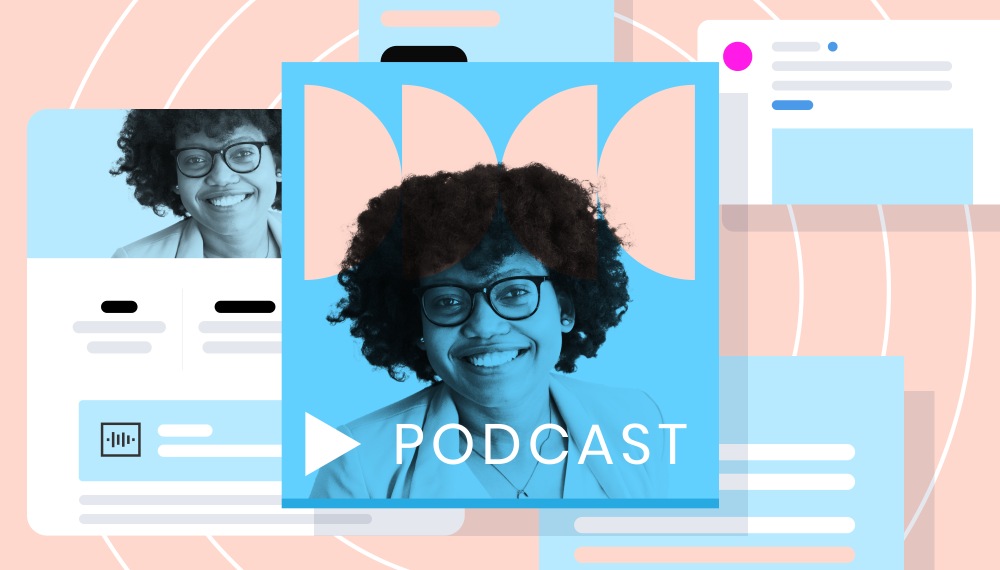
Imagine that you’ve hosted a glorious dinner party and carefully packed the leftovers into your fridge. There are a few approaches to leftovers: you can reheat them and create a lukewarm version of the food you’d enjoyed the night before. Or you can take your leftovers and kick them up a notch, either by adding more ingredients or transforming them into something entirely new.
It’s the same with event recordings: you can take your glorious content and feed your company and brand for days or weeks after. But it should never be a lukewarm version of the original.
And here’s the best part: you’re not starting from scratch. You’ve already done the hard work. Yet a lot of marketing teams treat event repurposing like an afterthought because it feels like too much additional work. They’re ready to move on to the next “new” thing.
AI can help you turn event repurposing into a low-lift effort. Better yet, you can bake it into your process (pun intended) so you know exactly the additional content you’ll be producing with each event.
- AI can be used to turn event recordings into new content, such as blog posts, ebooks, on-demand recordings, social posts, and podcast episodes
- Highlight key takeaways from the event to use as the basis for new content
- Save time by using AI to generate transcripts, quotes, and takeaways to use for the new content
- Break an event into smaller videos
1. Write a blog post
Ingredients:
- Event video file, YouTube link, or transcript
- AI writing tool
Before we get too creative, one of the most obvious ways to repurpose your event is to turn it into a blog post. After all, every new blog post involves coming up with angles and talking points — which your event will already have.
But don’t make the mistake of simply rehashing your event. People don’t want to read that (and if they do, they’ll read the transcript). You want to turn the event into something interesting: something that can stand on its own, even if people didn’t attend the event and didn’t watch the recording.
Even better: a blog post can be the basis for future repurposing, help with SEO, end up in your newsletter … it’s like the content gift that keeps on giving. If you link back to the original event recording within the post, you’re also opening the door for new people to watch it.
Since your blog post should reflect something new, you can take one key insight and expand on it further, or talk about all of the event’s takeaways (H2 for each? piece of cake!), or anything in between.
Your next steps:
- An AI-generated transcript can help you identify quotes from guests to incorporate into your draft
- AI can surface key takeaways and ideas, which can become the outline for your post
In WRITER, you can use recaps to generate takeaways from your events. Recaps will also give you insights and key quotes.
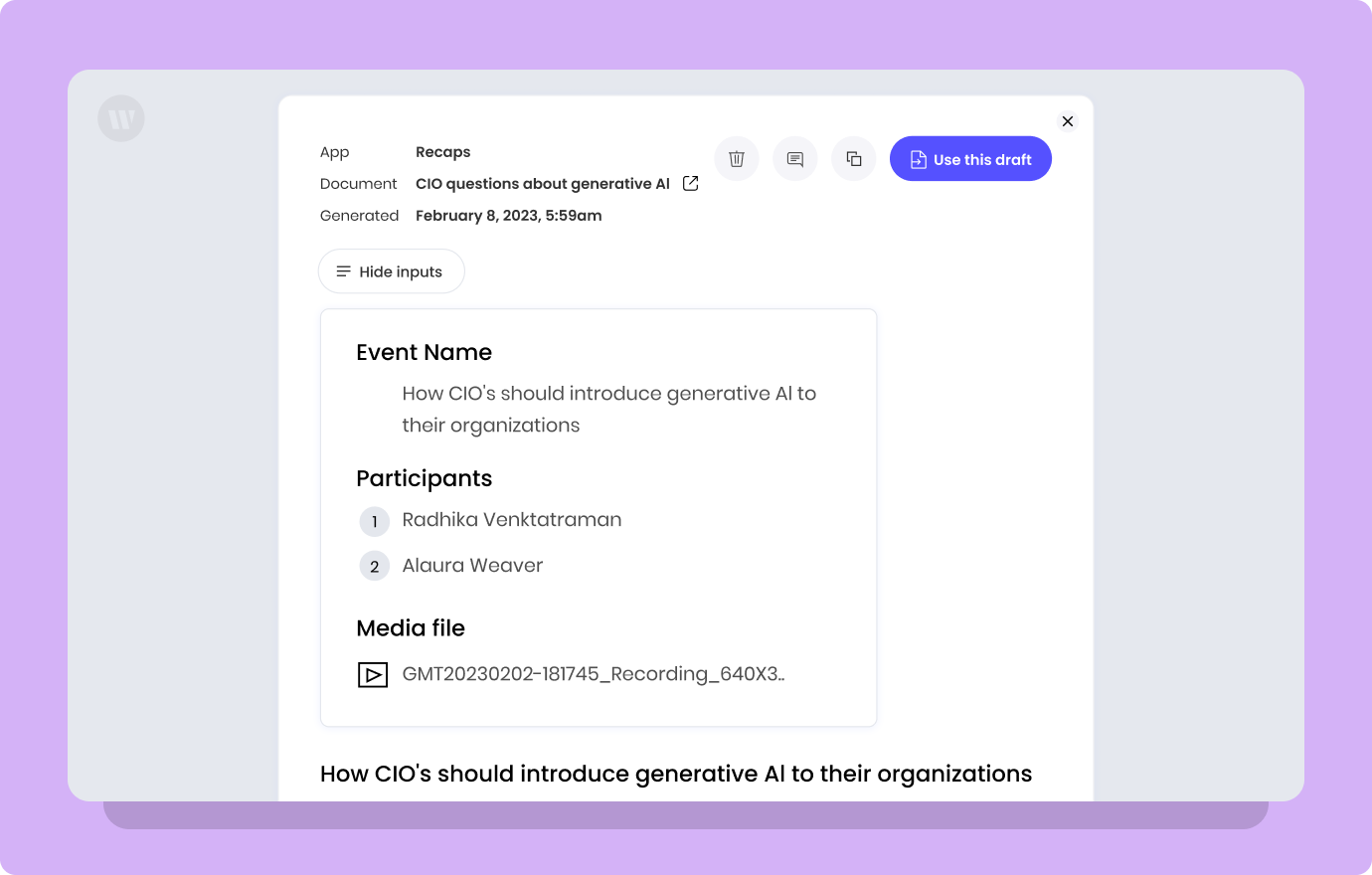
2. Expand with an in-depth eBook
Ingredients:
- Event video file, YouTube link, or transcript
- AI writing tool
- Designer
Some webinars are so meaty that they can be turned into a valuable eBook. Think about starting with each key takeaway and turning it into a full-blown chapter.
Yes, an eBook is a more involved project since it will not only be longer but also involve PDF creation. But the payoff could be huge. You could gate the eBook or use it for other demand capture purposes. And compared to coming up with an eBook from scratch, you’ll at least have something to work from.
With an eBook you can go deep — really, really deep. An event hosted with a panel of experts can be turned into a how-to guide or playbook. You can sprinkle in quotes and even include a CTA in the eBook that links back to the event recording. If the event included slides or other visuals, don’t be afraid to repurpose those in your eBook as well.
Your next steps:
- Start with the key takeaways, in the same way you would for a blog post
- Use AI prompting to help you expand on the ideas in your key takeaways. You might try:
- Identifying pain points
- Finding a counter-narrative
- Solving a tough problem
- Talking about new trends
With AI (like Ask WRITER or the /ask command in the Editor), you can use natural language prompts. Add each key takeaway, and then how you want to go deeper.
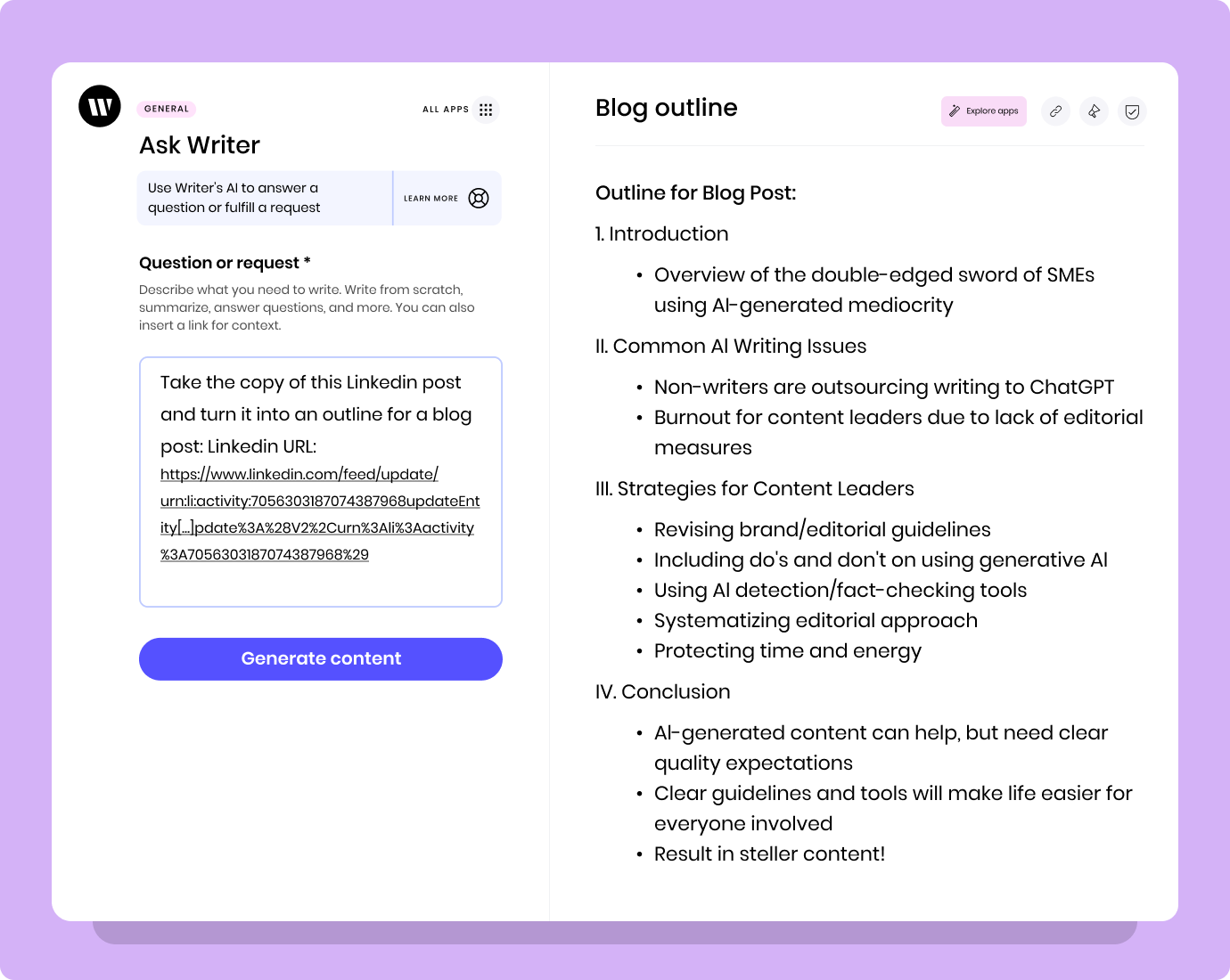
Pro Tip: Use the blog post builder app in WRITER to outline and draft sections of your eBook. You can totally use this app for blog posts also (obvs), but it can be really useful as you draft an eBook and want your separate chapters to have a similar flow.
3. Distribute an on-demand recording
Ingredients:
- Event video file
- AI editing tool
Live webinars have such potential for audience engagement (Q&A, chat, etc) but the number of people who want to attend versus actually attend can vary widely. You’re fighting time zones, scheduling conflicts, and last-minute emergencies.
But unless your event involved paid attendance, there’s no reason not to distribute the recording later. It’s like exponentially increasing your attendance — just not synchronous attendance. Which begs the questions: how should you edit the recording (if at all?)
You have to think about the watch-it-later audience’s perspective. Their experience isn’t the same as the live audience.
“One thing that you would want to do is edit out anything that makes it seem super live, like any tech glitches or long pauses, things like that,” says Meisha Bochicchio, Digital Content Marketing Program Manager at VMWare (This quote brought to you by WRITER recaps, based on our Content kitchen webinar.)
Video editing can become an entire process by itself, so if your team is strapped for time, you can use AI to speed things up.
Your next steps:
- AI video editing tools like Descript allow you to easily edit the video by removing entire sections
- Record and add an intro / outro, if appropriate — and reuse them in future videos!
Pro Tip: Always include a transcript and captions (generated by AI!) with your video recording. Transcripts and captioning make videos more accessible for dozens of reasons, ranging from sensory processing needs to search optimization and user preferences.
4. Break the event into smaller videos
Ingredients:
- Event recording
- Video editing tool and/or native editing within a platform (like TikTok)
Let’s face it: you may have recorded the most amazing hour-long event in the history of events, and some people won’t watch it because it’s “too long.” They want to consume content in small doses.
According to HubSpot, 85% of marketers say shortform videos are the most effective format on social media. Not only that, but it’s a lower bar for quality: you don’t need any fancy editing to post a video to Instagram.
How short should your videos be? Depends on what you’re trying to do:
- Create a series of videos on YouTube for each presenter on a panel
- Turn insightful quotes into a 30-second clip to share on social channels
- Remix a Q&A session into a bunch of TikTok videos
Your next steps:
- Look for obvious places in the event recording and transcript to create a snackable video
- Use the same steps that you’d use for an on-demand recording, but shorter
- Take the shortened video and edit it even more on TikTok or Instagram by adding text, effects, and more
Pro Tip: Don’t have great video for a great audio moment? Audiograms can be a great alternative, combining the audio with a little animation. (Check out Wavve)
5. Generate social posts (a lot of them!)
Ingredients:
- Event recording or transcript
- AI writing tool
- Visual editing tool
Humans speak at a rate of about 150 words per minute. If you’ve hosted a hour-long event, that’s a lot of words. Thousands of words. Think of the social post potential!
Let’s say you generate even a dozen social posts from one event. You can spread them out over several weeks’ time. And each time, drive people back to the event recording, or your blog, or that amazing eBook you created.
If you’ve done any of the previous suggestions, you’ve already built a solid foundation for your social posts through key takeaways, expert quotes, and short videos. Now it’s just a question of tweaking the content to fit the social platform.
Don’t forget to mix it up. Some social posts or quotes can be turned into eye-catching visuals with a tool like Canva.
Your next steps:
- Write an AI instruction to generate a social post based on the event recording, the transcript, or the key takeaways you’ve already pulled out
I used the highlights feature in WRITER to create a Twitter post based on my recap.
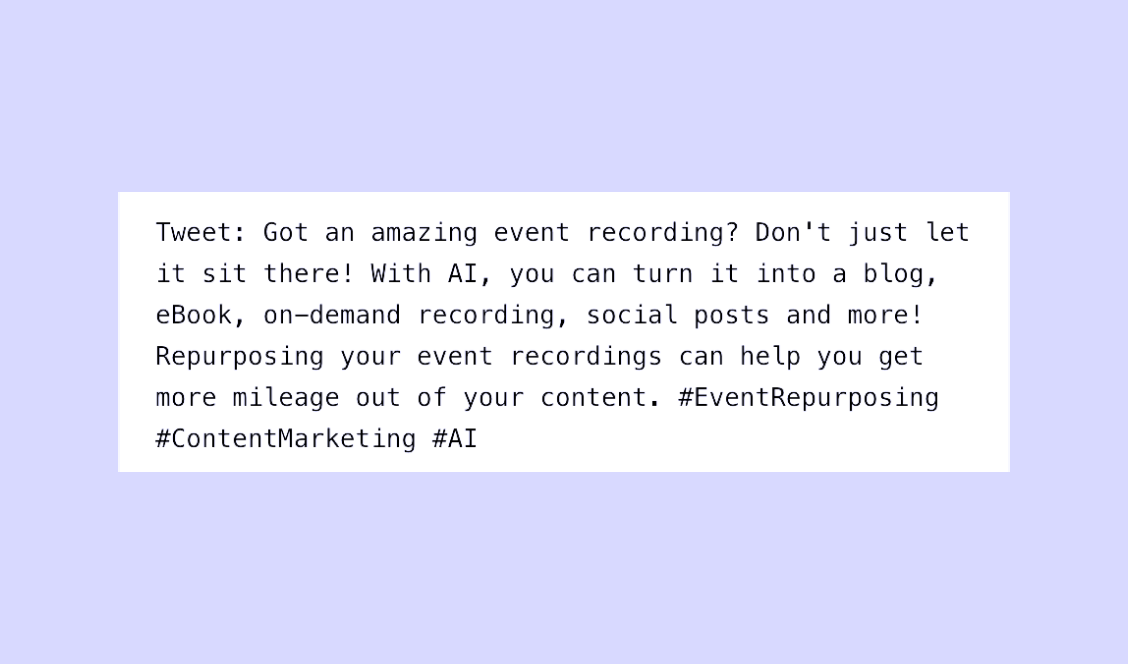
Or you can link to your transcript URL with Ask WRITER:
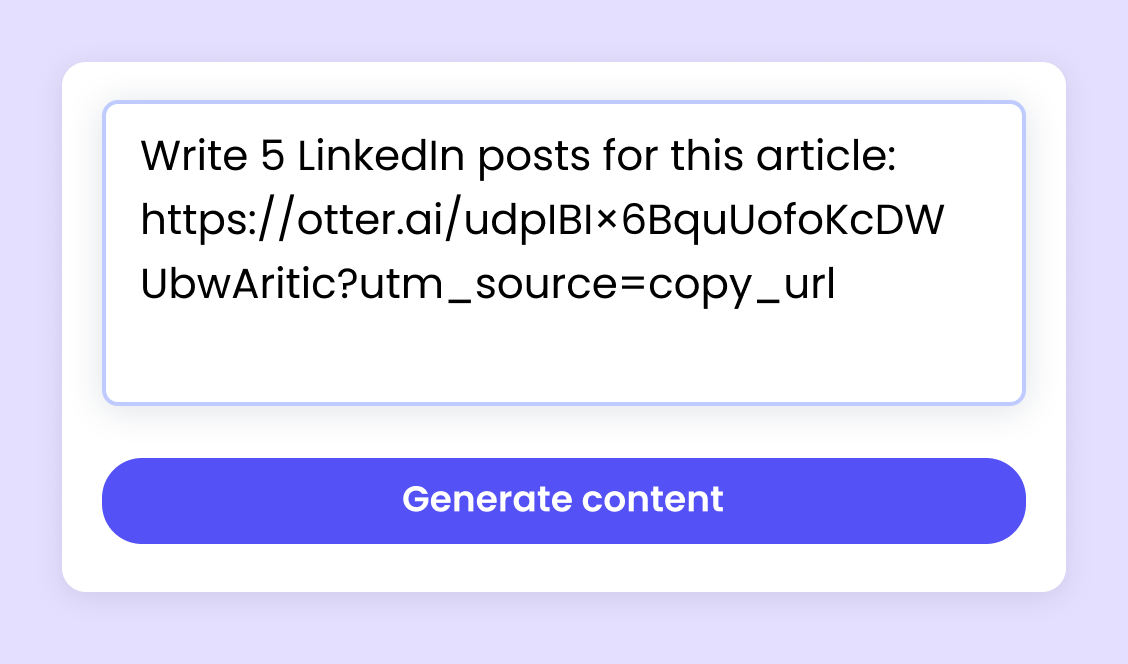
6. Land in your audience’s inbox with emails
Ingredients:
- Event recording or transcript
- AI writing tool
- Email marketing platform
You can’t always get your audience to come to you. Sometimes, you need to go to them. And by “go to them” I mean “send an email.”
Sending an email alerting your audience to the event recording is a low-lift, especially if the audience has consumed similar content in the past. But how can you make the event stretch even further?
Emails are a tricky business because if you send something annoying or not interesting, the recipient will head quickly for the “unsubscribe” button. There are a few ways to share your video content in a way that feels natural and not overly promotional.
You can craft an email for your sales team to use sharing a shorter clip rather than the full webinar. It could be sent to prospects in a “Hey, I thought this might interest you” type of way.
You could also create entirely new content, such as an email course, based on the event. This is a great way to distill educational content into bite-sized chunks — and some people may prefer that type of content directly in their inboxes. If you’ve already created a series of videos in Step 4, those can become the basis for your e-course (and, of course, share the video in the email, in case people also want to watch).
Your next steps:
- Use AI to help you write the CTA of your email, so you can get people engaged with content outside their inboxes
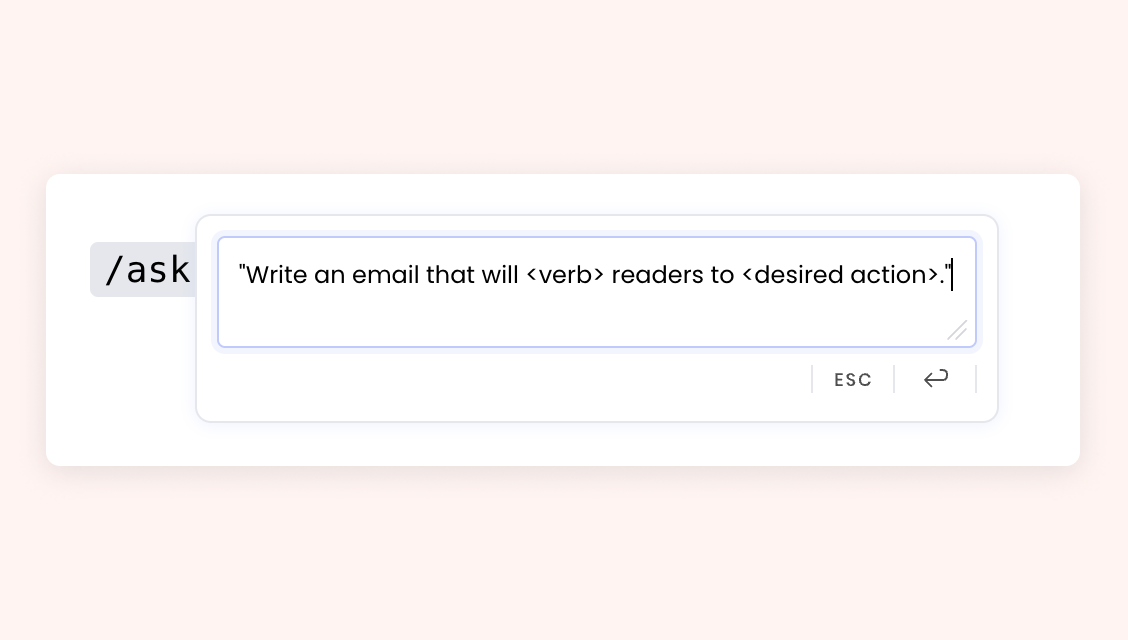
Pro Tip: Ashley Stryker, Senior Content Marketing Manager at Ivanti, shares her tips for using AI to write effective CTAs: “When you ask AI to write an email, you should also describe who is reading it and what you want them to do next – register for a webinar, listen to a podcast, sign up for a demo, etc. However, there are MANY different ways to describe what you want someone to do. Try different words with different connotations to see how AI will interpret them!”
Need some inspiration? Check out our prompt crafting guide!
Discover how Ashley and the Ivanti team use WRITER to repurpose podcasts, webinars, ebooks, and thought leadership content cross-channel: Powering Ivanti’s GTM pivot with enterprise-grade AI
Repurposed events take your content further
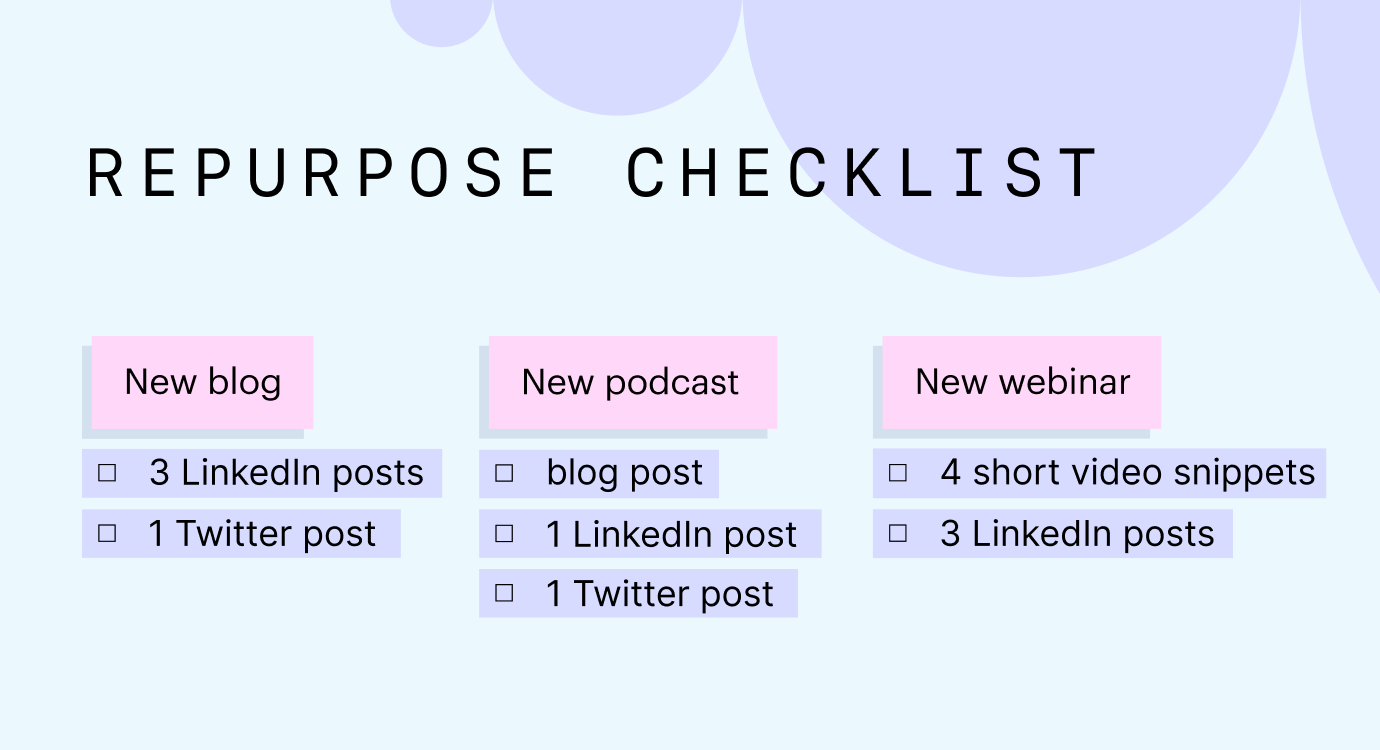
Whether you’ve hosted an event or are tasked with content distribution after the fact, you know that they’re a lot of work. Between coordinating guests, promoting the event, preparing the agenda, and hoping technology does its job, your company has invested considerable time and resources.
If you implement all of these suggestions, you’re going to make that investment go even further. If you do them without the help of AI? You’re spending more time than you need to. Time that could be better spent on new content. And writing every social post from scratch or trying to find the key takeaways by poring through a transcript? These can feel like mundane tasks for your team.
Build these steps into your content workflow and create a strong event repurposing process for your team. Don’t let that amazing event you cooked up go to waste.
(Are you going to look at leftovers in the same way next time you go to the fridge? Or can you see the potential?)
Can you count the number of food-related references in this post?